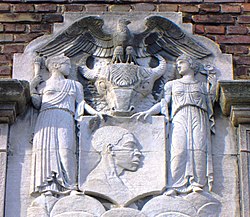Dunbar Apartments | |
 courtyard (2014) | |
| Location | W. 149th and 150th St btwn Frederick Douglass & AC Powell Jr. Blvds. Manhattan, New York City |
|---|---|
| Coordinates | 40°49′30″N73°56′18″W / 40.82500°N 73.93833°W |
| Area | 4.2 acres (1.7 ha) |
| Built | 1926–28 [1] |
| Architect | Andrew J. Thomas |
| Website | https://dunbarapts.com/ |
| NRHP reference No. | 79001601 [2] |
| Significant dates | |
| Added to NRHP | March 29, 1979 |
| Designated NYCL | July 14, 1970 |
The Dunbar Apartments, also known as the Paul Laurence Dunbar Garden Apartments or Dunbar Garden Apartments, is a complex of buildings located on West 149th and West 150th Streets between Frederick Douglass Boulevard/Macombs Place and Adam Clayton Powell Jr. Boulevard in the Harlem neighborhood of Manhattan, New York City. They were built by John D. Rockefeller Jr. from 1926 to 1928 to provide housing for African Americans, and was the first large cooperative aimed at that demographic. [1] The buildings were designed by architect Andrew J. Thomas and were named in honor of the noted African American poet Paul Laurence Dunbar.
Contents
The complex consists of six separate buildings with a total of 511 apartments (as constructed) and occupies an entire city block. The buildings center around an interior garden courtyard, with each building U-shaped so that every apartment receives easy air flow and direct sunlight at some point during the day. The Dunbar is considered the "first large garden-complex in Manhattan." [3]
The complex was designated a New York City Landmark in 1970, [1] and was listed on the National Register of Historic Places in 1979. [4]


